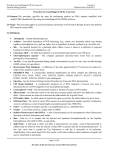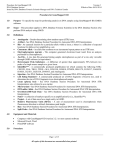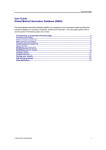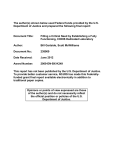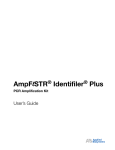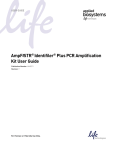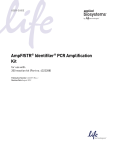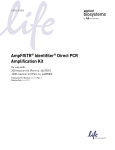Download Procedure for GeneMapper® ID for Casework 1.0
Transcript
Procedure for GeneMapper® ID for Casework Forensic Biology Section Issued by Forensic Biology Forensic Scientist Manager and DNA Technical Leader Version 6 Effective Date: 04/18/2014 Procedure for GeneMapper® ID for Casework 1.0 Purpose-This procedure specifies the steps for performing analysis on DNA samples amplified with AmpFℓSTR® Identifiler® Plus using the GeneMapper® ID (GMID) software. 2.0 Scope- This procedure applies to casework analysts and trainees in the Forensic Biology Section who perform DNA analysis using GMID. 3.0 Definitions Amelogenin – Gender-determining locus. Artifact – Non-allelic byproducts of PCR technology (e.g., stutter, etc), anomalies which occur during capillary electrophoresis (e.g., pull-up, spike, etc), or byproducts of primer synthesis (e.g., dye blob, etc). Bin – An expected location for a particular allele within a locus; a binset is a collection of expected locations for alleles at loci amplified as a set. Consensus Allele – An allele that conforms to an incremental repeat pattern at an STR locus. Electropherogram (egram) - The computer generated electronic/visual result from an analysis performed by electrophoresis. .fsa File - A raw data file generated during sample electrophoresis as part of a run; only viewable through GMID software (or equivalent). Identifiler® Plus - A commercially produced amplification kit which contains the following loci: CSF1PO, FGA, THO1, TPOX, vWA, D3S1358, D5S818, D7S820, D8S1179, D13S317, D16S539, D18S51, D21S11, D2S1338, D19S433, and Amelogenin. Injection - See the Forensic Biology Section Procedure for Use of the 3130XL Genetic Analyzer for Casework. LIZ Sizing Standard - A commercially produced set of DNA fragments of known size, used to determine the size of DNA fragments in an electrophoresed sample. Locus (plural = Loci) - The chromosomal location or location of a gene or DNA marker. Microvariant - An allele that varies by less than the consensus repeat unit and is not defined by a ladder allele. Microvariants are observed in-between the ladder alleles for a specific locus. Noise – Signal detected by a data collection instrument. Off Ladder Allele - Alleles that size outside the allele categories (bins) represented in the ladder. Off-Scale Data - The result of excess DNA present in an electrophoresed sample, typically visualized by excessive artifacts as a result of peak heights consistently greater than 7000 RFUs. Panel – A collection of markers specific to an amplification kit (i.e., Identifiler Plus). Project – A set of data saved as a single entity in GMID. Relative Fluorescence Units (RFUs) – A unit of measurement used in electrophoresis when fluorescence detection is utilized; determines peak height. Run - See the Forensic Biology Section Procedure for the Use of the 3130XL Genetic Analyzer for Casework. Split Peaks - A split peak is where one allele is represented by two peaks. Lack of full nucleotide A addition may be observed when the amount of input DNA is greater than the recommended protocol. In this case, more time is needed for Taq Polymerase to add the A nucleotide to all molecules. Page 1 of 15 All copies of this document are uncontrolled when printed. Procedure for GeneMapper® ID for Casework Forensic Biology Section Issued by Forensic Biology Forensic Scientist Manager and DNA Technical Leader Version 6 Effective Date: 04/18/2014 Amplification of too much input DNA also results in off-scale/overblown data (saturation of signal) and may be manifested as split peaks. 4.0 Equipment and Materials Computer with GeneMapper® ID (version 3.2.1 or most current) software Microsoft Excel, Word Print2PDF software 5.0 Procedure 5.1 Setting Analysis Parameters for GMID: Each user shall import from the Section Shared Drive the following files as required for the type of analysis being performed into his/her copy of GMID prior to analysis (if not already present). 5.1.1 Analysis Methods 5.1.2 Panels/Bins 5.1.3 Identifiler_Plus_Panels_v1.txt Identifiler_Plus_Bins_v1.txt Size Standards 5.1.4 Identifiler_Plus_AnalysisMethod_v1.xml CE_G5_Identifiler_Plus_GS500.xml Tables and Plot Settings SBI Casework Table.xml AmpFLSTR Sizing plot.xml Case Allele Table.xml Overlay LIZ plot.xml AmpFLSTR Genotyping plot.xml AmpFLSTR Table.xml CODIS Export Table.xml 5.2 Creating a Project 5.2.1 Open GMID and log in under the Forensic Scientist’s name/log-in. Analysis under the generic gmid log-in name is not permitted. 5.2.2 Select File and Add samples to project. Page 2 of 15 All copies of this document are uncontrolled when printed. Procedure for GeneMapper® ID for Casework Forensic Biology Section Issued by Forensic Biology Forensic Scientist Manager and DNA Technical Leader Version 6 Effective Date: 04/18/2014 5.2.3 Locate the run folder containing the samples to be added to the project under the Files tab. Highlight the run folder (or select the specific samples to be analyzed) and select Add to List. The file(s) then appears on the right-hand side. Select Add. 5.2.4 In the Samples pane, the category Sample Type shall have the samples labeled as follows when amplified with Identifiler® Plus: Ladder: Allelic Ladder 9947A (Positive Amplification Control): Positive Control Negative Amplification Control: Negative Control All other samples shall be Samples Note: Sample File names appear by well number (e.g., A12) followed by the sample name as entered by the Forensic Scientist prior to electrophoresis. Also, until the samples are analyzed, the Status icon to the left of the Sample File name has the unanalyzed icon ( ) present next to it. If no Status category or icons are present, verify that the table setting (in top center of the main GMID window) is set to AmpFLSTR Table. 5.2.5 The remaining categories shall be filled out as follows: Specimen Category: no export Analysis Method: Identifiler_Plus_AnalysisMethods_v1 Panel: Identifiler_Plus_Panels_v1 Size Standard: CE_G5_IdentifilerDirect_GS500 Instrument Type: ABI3130, or similar (note: automatically filled in by the software and instrument) 5.2.6 Once all samples and categories are properly labeled and identified, select the Analyze icon ( ) to analyze the data. When prompted, create a project name for the set of samples and select Save. 5.2.6.1 Note: GMID auto-saves data after every 10 samples have been processed. 5.2.6.2 Note: The Genotypes tab becomes available in the main GMID window once analysis is complete. 5.2.6.3 Note: If any sample displays a solid red stop sign icon ( GMID window, assess the data as described in 5.3. 5.2.7 ) on the right-hand side of the Analysis and Plot Settings 5.2.7.1 Access the Analysis Method Editor by selecting Analysis from the menu in the main GMID window, and then select Analysis Method Editor. Note that the user must have a single sample in the main GMID window selected in order to access the Editor. 5.2.7.2 Select the Peak Detector tab and ensure that the settings for Peak Detection, Smoothing and Baselining, and Size Calling Method are as seen below when the samples have been Page 3 of 15 All copies of this document are uncontrolled when printed. Procedure for GeneMapper® ID for Casework Forensic Biology Section Issued by Forensic Biology Forensic Scientist Manager and DNA Technical Leader Version 6 Effective Date: 04/18/2014 amplified with Identifiler® Plus. Note that the Peak Threshold is set to 50 for all dye channels. 5.2.7.3 Next select the Allele tab; the contents should appear as below: Page 4 of 15 All copies of this document are uncontrolled when printed. Procedure for GeneMapper® ID for Casework Forensic Biology Section Issued by Forensic Biology Forensic Scientist Manager and DNA Technical Leader Version 6 Effective Date: 04/18/2014 5.2.7.4 Marker-specific stutter filter percentages for Identifiler® Plus are listed below. Locus % Stutter D8S1179 10.3155 D21S11 10.6714 D7S820 9.6926 CSF1PO 9.2041 D3S1358 12.2719 TH01 4.0813 D13S317 9.9348 D16S539 10.3945 D2S1338 12.4409 D19S433 11.2096 vWA 12.446 TPOX 6.3832 D18S51 13.6799 D5S818 10.0599 FGA 13.028 Page 5 of 15 All copies of this document are uncontrolled when printed. Procedure for GeneMapper® ID for Casework Forensic Biology Section Issued by Forensic Biology Forensic Scientist Manager and DNA Technical Leader Version 6 Effective Date: 04/18/2014 5.2.7.5 In the main GMID window, select Tools from the top menu, and then select Table Setting Editor. Under the Genotypes tab, at the bottom of the window, ensure that the Number of Alleles under Allele Settings is set to at least 12. Forensic Scientists may adjust this number if necessary (e.g., to maximum number of called alleles at any locus). 5.2.8 Adding/Deleting samples 5.2.8.1 If a Forensic Scientist must add additional sample(s) to a current project, follow 5.2.3 through 5.2.8. The newly added sample shall be analyzed (select the Analyze icon) before the data can be viewed. 5.2.8.1.1 Note: If the sample is from a different injection (e.g., run folder), the associated Allelic ladder shall also be imported in order for the sample data to be sized properly. 5.2.8.2 If a Forensic Scientist must remove a sample(s) that has been added to the project (e.g., a sample from an unrelated case), highlight the sample to be removed and in the menu bar, select Edit and Delete from Project. Select OK when prompted. 5.2.8.2.1 Note: Samples from the same case that are present in a project but are not used (e.g., redundancy, sizing data issues or similar) shall not be deleted (refer to 5.3.2.3.2). 5.3 Analyzing/Preliminary Evaluation of Data of Each GMID Project 5.3.1 Evaluate Sizing Data (e.g., LIZ) 5.3.1.1 Select Edit from the GMID menu bar at the top of the window and Select All. Click on the Size Match Editor Icon ( ). The new window that opens displays the LIZ sizing Page 6 of 15 All copies of this document are uncontrolled when printed. Procedure for GeneMapper® ID for Casework Forensic Biology Section Issued by Forensic Biology Forensic Scientist Manager and DNA Technical Leader Version 6 Effective Date: 04/18/2014 data for all selected samples; scroll through each one and confirm that all sizing peaks are correct (75, 100, 139, 150, 160, 200, 300, 350, 400 and 450-base pairs). Close this window. 5.3.1.1.1 Note: If all peaks are not called, the analysis range may need to be extended; view the Analysis Settings in 5.2.8.2 and change the analysis range to Full Range in the Peak Detector tab. 5.3.1.2 Again select all the samples in the main GMID window and select the Display Plots icon ( ). This opens the Sample Plot window for all selected samples. Change the Plot Setting to Overlay LIZ by selecting it from the dropdown menu in the top left portion of the Sample Plot window. Zoom in to the area near the 250-base pair peak (bp) by holding the mouse just above the horizontal scale, indicating bp size, and then clicking and dragging to zoom. 5.3.1.2.1 Note: the 250-bp peak was not defined by the manufacturer in the size standard. The purpose of checking this sizing peak is to determine if the 250bp peak within the samples and controls are within +/- 0.5 bp of the 250-bp sizing peak of the allelic ladder with which they were injected. Therefore, no sample or control run in-house shall be used for analysis if its 250-bp peak falls outside this window in relation to the allelic ladder. Any sample or control that exceeds the window shall be re-injected (refer to the Forensic Biology Section Procedure for Use of the 3130XL Genetic Analyzer for Casework for reinjection requirements). 5.3.1.3 Highlight the 250-bp peak and hold down the Ctrl and S key on the keyboard to select all samples at the 250-bp peak. The sizing table then displays the 250-bp peak size for all selected samples. If any sample has a 250-bp peak which is greater than +/- 0.5 bp from the 250-bp peak in the associated allelic ladder, refer to 5.3.1.2.1. 5.3.1.4 If any sample or reagent blank in the project indicates no sizing data (e.g., LIZ failure), then that sample or reagent blank shall not be used for comparison. This information shall be noted on the Casework Table Worksheet. If there is no sizing data for an allelic ladder, then no data associated with that ladder can be sized. 5.3.1.4.1 If the allelic ladder has no sizing data, a ladder which was injected on the same plate on the same day by the same Forensic Scientist may be used to size the run. 5.3.1.4.2 If an amplification control has no sizing data, a duplicate control from the same plate/day/Forensic Scientist which originated from the same amplification product may be used. 5.3.1.4.3 Any sample/reagent blank that has no sizing data shall be re-injected. Page 7 of 15 All copies of this document are uncontrolled when printed. Procedure for GeneMapper® ID for Casework Forensic Biology Section Issued by Forensic Biology Forensic Scientist Manager and DNA Technical Leader 5.3.2 Version 6 Effective Date: 04/18/2014 Assess Overall Quality of Data 5.3.2.1 Allelic Ladders and Controls 5.3.2.1.1 In the main GMID window, select the allelic ladder(s) and open the sample plot window by selecting the Display Plots icon. In the Samples Plot window, ensure that the Plot Setting is set to AmpFLSTR Genotyping. 5.3.2.1.2 Scroll through each of the color channels (blue, green, yellow, red) and verify that all the alleles are sized and labeled correctly according to the expected calls for the Identifiler® Plus Allelic ladder. All expected peaks must be present and above the appropriate analytical threshold. Close this Sample Plot window. 5.3.2.1.3 In the main GMID window, select the positive and negative amplification and extraction controls (if applicable). Open the sample plot window as described previously. 5.3.2.1.4 Examine the positive control(s) for the expected allelic results and to ensure that the negative controls meet the required interpretive guidelines (see the Forensic Biology Section Procedure for Casework DNA Interpretation with Identifiler® Plus). Remove any artifacts as described in 5.3.2.2.1.1. Close the Sample Plot window. 5.3.2.2 Samples 5.3.2.2.1 Examine all samples in the manner as described for the allelic ladders and controls. 5.3.2.2.1.1 Artifacts: If any peaks are to be removed from consideration as true alleles due to their presence as a known artifact (e.g., pull-up, dye-blob, stutter, spike), highlight the sizing box associated with the peak and right-click the mouse. Select Delete Allele(s) (multiple peaks can be deleted simultaneously by selecting them at the same time-when the warning dialog box appears, select OK). When prompted by the Delete Allele Comment, type in artifact. 5.3.2.2.1.2 Off-ladder Alleles and Microvariants: If a sample(s) contains an off-ladder allele that is not an artifact or a microvariant is present in a sample and GMID has not automatically assigned it an allelic value, Forensic Scientists shall document the proper sizing/locus assignment of the off-ladder alleles and/or microvariant as follows: 5.3.2.2.1.2.1 If the allele in question lies outside the marker range of a locus (e.g., between two loci, above or below Page 8 of 15 All copies of this document are uncontrolled when printed. Procedure for GeneMapper® ID for Casework Forensic Biology Section Issued by Forensic Biology Forensic Scientist Manager and DNA Technical Leader Version 6 Effective Date: 04/18/2014 the end of the color channel), the Forensic Scientist shall attempt to determine to which locus the allele should be assigned based upon the presence or absence of heterozygosity at the loci in question. 5.3.2.2.1.2.2 If one locus exhibits homozygosity and the second heterozygosity, the off-ladder allele shall be assigned to the homozygous locus. 5.3.2.2.1.2.3 If both loci exhibit homozygosity or heterozygosity, the Forensic Scientist shall document either on the allele call table or the electropherograms that the allele was observed, but not assign the allele to a particular locus, and mark the allele as inconclusive (INC). The called (non off-ladder) alleles at these loci shall be reported and uploaded into CODIS. 5.3.2.2.1.2.4 Note: In some instances, an off-ladder allele from one locus may appear within an adjacent locus (i.e., appears to be a potential triallele next to a homozygous locus). If based on training and experience the Forensic Scientist believes such a situation has occurred, the entire locus containing that allele may be marked as inconclusive. 5.3.2.2.1.2.5 A microvariant or an off-ladder allele shall be named/assigned per NDIS standards. For CODIS eligibility, refer to the Forensic Biology Section Procedure for CODIS. 5.3.2.2.1.2.6 In the main GMID window, select the sample(s) containing the microvariant/ off-ladder allele and the allelic ladder. Display Plots. Zoom in to the locus containing the microvariant/off-ladder allele; the Sample Plot displays the allelic ladder in the top half of the Plot window and the sample is in the bottom half. 5.3.2.2.1.2.7 Highlight the microvariant/off-ladder allele in the sample, along with the alleles in the allelic ladder that lie the closest in size to the microvariant/offaldder allele (to select peaks simultaneously, hold down the Ctrl key on the keyboard while selecting). Page 9 of 15 All copies of this document are uncontrolled when printed. Procedure for GeneMapper® ID for Casework Forensic Biology Section Issued by Forensic Biology Forensic Scientist Manager and DNA Technical Leader Version 6 Effective Date: 04/18/2014 Select the sizing table icon ( ). Select Ctrl + S to make the sizing table display the selected alleles. 5.3.2.2.1.2.8 Based upon the sizing information provided in the table, determine the appropriate allele call for the microvariant/off-ladder allele. 5.3.2.2.1.2.8.1 Note: the correct allele call for the microvariant/off-ladder allele is dependent upon the base pair size when compared to the allelic ladder. 5.3.2.2.1.2.8.2 Note: microvariants that vary by less than the consensus repeat unit for that locus must be designated as an integer of that variation (e.g., the 9.3 allele at TH01). 5.3.2.2.1.2.9 Rename the allele by right-clicking on it and selecting Rename Allele. If the correct allele call is not already present in the subsequent drop-down list, select Custom and enter the call in the Create Custom Allele Name box. When prompted by the Edit Allele Comment box, type in microvariant or off-ladder allele. 5.3.2.2.1.2.10 With the alleles highlighted in 5.3.2.2.1.2.7 still present in the sizing table (remove any extraneous), add a copy to the appropriate Case Record Object Repository in FA. 5.3.2.2.1.3 Single Occurrence Off-Ladder Alleles: If an allele at any locus results in an off ladder call by GMID, the sample shall be reinjected (or re-amplified, if necessary) in order to verify the size of the allele(s) if the Forensic Scientist wants to use the results at that locus (see the Forensic Biology Section Procedure for the Use of the 3130XL Genetic Analyzer for Casework). Shifted alleles/loci shall not be used for comparison in any control, ladder or sample. 5.3.2.2.1.4 Off-scale Samples: Off-scale samples shall not be used for comparison. Such samples shall be re-amplified with a lower concentration. 5.3.3 Printing Egrams Electronically Page 10 of 15 All copies of this document are uncontrolled when printed. Procedure for GeneMapper® ID for Casework Forensic Biology Section Issued by Forensic Biology Forensic Scientist Manager and DNA Technical Leader Version 6 Effective Date: 04/18/2014 5.3.3.1 The egrams for any well in which data is collected (e.g., blank, ladder, item, etc.) shall be printed and the egrams for each GMID project shall exist as an individual PDF file. 5.3.3.1.1 Note: GMID projects are added to the FA case record object repository by exporting the projects: in GMID, select Tools, GeneMapper Manager, select the applicable project and select export. The file is exported/saved as a .ser file. 5.3.3.2 Any individual sample/control/ladder with the case that is not used for comparison purposes (e.g., LIZ failure, redundancy, further analysis) shall be added to the appropriate FA Case Record Object Repository. Such samples/controls/ladders shall appear in the Casework Table explaining why it was not used for comparison (e.g., LIZ failure, redundancy, re-analysis). 5.3.3.2.1 Note: Even if not used for comparison purposes, all .fsa files associated with such samples/controls/ladders shall be present in the run folder containing the electronic data in the FA case record object repository. 5.3.3.2.2 Note: For any sample/control/ladder that is not used for comparison purposes, corrections (labeling of artifacts) are not required. 5.3.3.3 If an entire run or project for a case is not used for comparison purposes, it shall be added to the case record object repository. Corrections (e.g., labeling of artifacts) are not required in this instance. A Casework Table shall be generated for this instance and the reason for not using the entire run/project shall be noted on this page (also Print2PDF; see 5.4.1). An Allele Call Table is not required for such runs/projects. 5.3.3.4 The LIZ sizing standard shall be printed as a separate set of egrams which may be added to the overall egram PDF file for each project, or kept separately as an independent document. The LIZ must be present for all samples/controls/ladders and all peaks (75 through 450) must be visible. 5.3.4 View Raw Data 5.3.4.1 In order to verify the addition of amplification kit primers to all negative controls and negative samples (which includes instances of LIZ or injection failure), the raw data for such samples from each project must be present in each case record object repository. 5.3.4.1.1 In the main GMID window, highlight the negative control or negative sample and select Raw Data from the View option in the main GMID menu. 5.3.4.1.2 The subsequent window displays the raw data on the right-hand side and the sample and run information on the left-hand side. Expand the left-hand Page 11 of 15 All copies of this document are uncontrolled when printed. Procedure for GeneMapper® ID for Casework Forensic Biology Section Issued by Forensic Biology Forensic Scientist Manager and DNA Technical Leader Version 6 Effective Date: 04/18/2014 window so that the full run file name (including run number) is clearly visible. The right-hand window shall show the maximum vertical and horizontal axis. 5.3.4.1.3 Using the Alt + Print Screen buttons on the computer, take a snapshot of the raw data. Open up a Word document and paste this snapshot into the document. Repeat this process for all negative samples and negative controls in each project. 5.3.4.1.3.1 This raw data Word document shall contain at least the following information in the header: full case number, date and Forensic Scientist’s initials. 5.3.4.1.4 The Word document(s) containing the snapshots of the raw data shall be saved/printed as a .pdf file and included in case record object repository. 5.4 Exporting and Creating Tables 5.4.1 Casework Table 5.4.1.1 In the main GMID window, select the SBI Casework Table from the Table Setting menu. 5.4.1.2 Select all samples and under File in the main GMID menu, select Export table. Save the table to a location easily located by the Forensic Scientist (e.g., desktop or thumb drive). Ensure the file is exported/saved in the Tab- and Comma-delimited Text. 5.4.1.3 Open Excel; open the .txt file saved in the previous step (note: the Forensic Scientist may have to change the file of type to All Files in order for the software to access the .txt file). 5.4.1.4 When the Text Import Wizard opens, select Finish. 5.4.1.5 Adjust the columns to accommodate the full text for each line. 5.4.1.6 Select Page Setup. Under the Page tab, select landscape and fit to 1 page wide by 1 page tall; under the Header/Footer tab, select Custom Header – at a minimum, the Forensic Scientist shall enter the full case number, initials and the date; under the Sheet tab, select only the Gridlines box. Finish by selecting OK. Alternately, the Forensic Scientist may use the Casework Table Worksheet to create this table. 5.4.1.7 Forensic Scientists shall note on this page any samples that are not to be used for comparison and why, or those that are to have additional analysis performed on them (see 5.3.3.2). Page 12 of 15 All copies of this document are uncontrolled when printed. Procedure for GeneMapper® ID for Casework Forensic Biology Section Issued by Forensic Biology Forensic Scientist Manager and DNA Technical Leader Version 6 Effective Date: 04/18/2014 5.4.1.8 The Casework Table Worksheet shall exist independently of the egrams and the Allele Call Table Worksheet(s). It may be merged with the 3130 setup sheet and saved/printed as a .pdf file. 5.4.1.9 Note: Only samples and controls specific to the case shall be present in the Casework Table. 5.4.2 Allele Call Table 5.4.2.1 In the main GMID window, select the Case Allele Table from the Table Setting menu. With all samples selected, select the Genotypes tab in the main GMID menu. 5.4.2.2 Under the File menu in the main GMID window, select Export Table. Save the table to a location easily located by the Forensic Scientist on his/her computer (e.g., desktop or thumb drive). Ensure the file is exported/saved in the Tab- and Comma-delimited Text (.txt) format. 5.4.2.2.1 Note: the Forensic Scientist may need to add additional information to the .txt file name in order to avoid copying over the Casework Table file. 5.4.2.3 Open Excel; open the .txt file saved in the previous step (note: the Forensic Scientist may have to change the files of type to All Files in order for the software to access the .txt file). 5.4.2.4 When the Text Import Wizard opens, select Finish. 5.4.2.5 Open the Allele Call Table Excel file in the Forensic Biology Shared Folder. Copy and paste the allele calls generated from the .txt file in 5.4.2.4 (Select All) into the Results tab in the appropriate Allele Call Table Worksheet. 5.4.2.6 Return to the Allele Call Table tab (or the Mixture tabs if any samples have more than 2 alleles at any given locus) and verify that the copy and paste function worked properly. 5.4.2.7 If minor alleles or profiles are to be marked, the Forensic Scientist shall indicate these with parentheses. Alleles that fall within the stochastic range (i.e., between the AT and the ST) shall have their cells highlighted. Minor alleles shall be marked if an analyst is calling that/those locus/loci predominant in a mixture. Analysts are not required to mark minor alleles if predominance is not being reported. 5.4.2.8 If multiple injections are present in a case file due to re-extraction, re-amplification, or reinjection (non-serial in nature), the Forensic Scientist shall indicate from which run number the sample came. Item descriptions shall also be typed into the designated areas in the worksheet. The Forensic Scientist shall ensure their initials are typed on each page of the worksheets, as well as the full case number and the date. Page 13 of 15 All copies of this document are uncontrolled when printed. Procedure for GeneMapper® ID for Casework Forensic Biology Section Issued by Forensic Biology Forensic Scientist Manager and DNA Technical Leader Version 6 Effective Date: 04/18/2014 5.4.2.9 It is permissible for the Forensic Scientist to combine all Allele Call Table Worksheets into one Excel spreadsheet. 5.4.2.10Any and all notes, remarks, and observations used by the Forensic Scientist to make an interpretation and/or conclusion regarding a question sample shall be noted on the Allele Call Table Worksheet(s). Full, single source samples above stochastic threshold and samples that produce no DNA profiles do not have to be noted. (See Forensic Biology Section Procedures for Casework DNA Interpretation and Statistical Calculations.) 5.4.2.11Allele call tables for the question and known samples shall be generated and included as separate .pdf files in the appropriate Case Record Object Repository. 5.4.2.12Note: Only samples specific to the case shall be present in the Allele Call Table (i.e., controls, unlabeled/unassigned allele call tables, and ladders shall not be printed). 5.4.3 CODIS Table 5.4.3.1 Refer to the Procedure for CODIS for CODIS Table Export. 5.4.3.2 Refer to the Procedure for CODIS for Specimen Upload. 6.0 Limitations - GMID cannot be used on computers operating on Windows 7 or higher. 7.0 Safety - N/A 8.0 References Applied Biosystems™. GeneMapper® ID Software Version 3.1 User’s Guide. P/N 4338775 Rev. C. Applied Biosystems™. AmpFℓSTR® Identifiler® Plus PCR Amplification Kit User’s Manual. P/N 4440211 Rev. D. Forensic Biology Section Procedure for Casework DNA Interpretation Forensic Biology Section Procedure for Use of the 3130XL Genetic Analyzer for Casework Forensic Biology Section Procedure for CODIS NDIS STR Data Entry Software (accessible by registered CODIS users only) 9.0 Records Identifiler® Plus Allelic Ladder Expected Results Identifiler® Plus 9947A Expected Results Page 14 of 15 All copies of this document are uncontrolled when printed. Procedure for GeneMapper® ID for Casework Forensic Biology Section Issued by Forensic Biology Forensic Scientist Manager and DNA Technical Leader Version 6 Effective Date: 04/18/2014 10.0 Attachments - N/A Revision History Effective Date Version Number Reason 01/04/2013 1 Original Document 03/08/2013 2 5.2.7.2 – Updated screen shot, clarified wording as to which settings are required from the screen shot; 5.4.2 - Removed requirement to mark allelic drop-out on allele call table (old 5.4.2.10), causing subsequent renumbering of remainder of 5.4.2 03/22/2013 3 Changed off-ladder definition; 5.3.2.2.1.2 – combined Off ladder and microvariant sections (5.3.2.2.1.3.1 through 5.3.2.2.1.3.4 moved); removed 5.3.2.2.1.2.6, 5.3.2.2.1.3, 5.3.2.2.1.3.5 through 5.3.2.2.1.3.8, 5.3.2.2.1.3.8.1, and 5.3.2.2.1.6; clarified wording for sizing shifts (5.3.2.2.1.4); removed print to pdf 5.3.3.1 through 5.3.3.4, 5.3.4.1.4, 5.4.1.8, and 5.4.2.11. 09/13/2013 4 5.3.3.1 – clarified all wells where data is collected shall be printed; 5.4.2.3 – removed Database Analyst; 5.4.2.7 – removed key requirement (part of controlled form) and added clarification for marking minor alleles; 5.4.2.8 – clarified when run number should be recorded; 5.4.2.10 – clarified types of notes necessary for call table; 5.4.2.12 – clarified what items shall be printed 12/18/2013 5 Header – added issuing authority 0/18/2014 6 3.0 – updated definitions; 5.3.1.4 – clarified wording for requirement; 5.3.2.2.1.2.1 – updated to include alleles at ends of channels; 5.3.2.2.1.2.6, 5.3.2.2.1.2.6, 5.3.2.2.1.2.7, 5.3.2.2.1.2.8, 5.3.2.2.1.2.9 – added off-ladder; 5.3.2.2.1.3 – clarified wording; 5.3.4.1.4 and 5.4.1.8 – added pdf requirement; 5.4.2.10 – added reference; 5.4.2.11 – clarified requirement for separate allele call tables Page 15 of 15 All copies of this document are uncontrolled when printed.

















